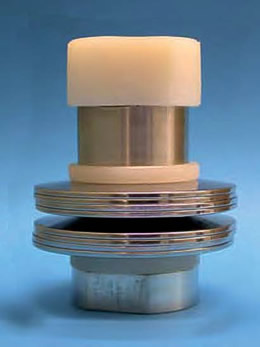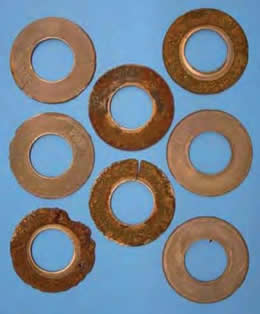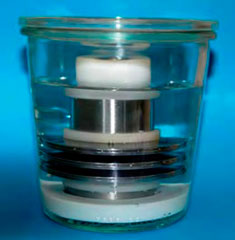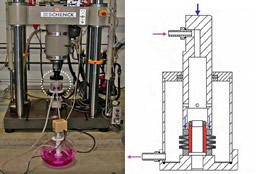TEST METHODOLOGY
 The results shown in these tests, respond to a research proposal, supervised by the Spring Association (VDFI), spring sub-committee of or Disc Spring, through the Technical University of Darmstadt.
The results shown in these tests, respond to a research proposal, supervised by the Spring Association (VDFI), spring sub-committee of or Disc Spring, through the Technical University of Darmstadt.
We must indicate first of all, that the result of these tests, is valid for the conditions in which they have been made and the materials and coatings of the parts used. It is important to note that in real cases, they can affect variations of the conditions that affect the result of corrosion. We must take the result of these tests, as an orientation regarding the behavior of materials and coatings, in different situations of corrosion.
We recommend to contact our technicians for the study of a real case. They will provide you advice to select the most appropriate solution.
Test Samples
With the intention of establishing a homogeneous methodology, the materials and coatings selected for all the tests are all the same. With this, we can make comparisons regarding the resistance of the pieces in different conditions, both with respect to the corrosive agents, as well as the temperature or the tension or fatigue conditions of the pieces.
Belleville washers used in the tests belong to the following dimensions:
- 63 x 31 x 1,9 x 4,5 (C)
- 1.4310 - C
- 80 x 41 x 3 x 5,3 (B)
- 1.4310 - B
- 63 x 31 x 1,8 x 4,15 (C)
- 1.4568 - C
- Coatings
Selected materials and coatings to be used in the tests are the following ones:
Materials:
 It is identified the type of stainless material, the series of the spring (type A, B or C) which determines the ratio of thickness regarding the size of the piece, and the manufacturing method.
It is identified the type of stainless material, the series of the spring (type A, B or C) which determines the ratio of thickness regarding the size of the piece, and the manufacturing method.
- 1.4310 - C - Stamping - Rectified
- 1.4310 - C -Stamping - Rectified - shot peened
- 1.4310 - B - Stamping - Rectified
- 1.4568 - C - Stamping - Rectified
- 1.4568 - C - Stamping - Rectified - shot peened
- 1.4568 - C - Stamping - Rectified - Kolsterised
-
Shot peened: It is a treatment of bombardment of the piece with metallic balls, which increases the resistance spring to fatigue.
-
Kolterised:Treatment that improves wear resistance in austenitic stainless steels.
Coatings
 Applied on 51CrV4 steel parts
Applied on 51CrV4 steel parts
- Mechanical Zinc + Yellow chromed
- Mechanical Zinc + Transparent chromed
- Dacromet
- Geomet
- Delta Tone + Delta Seal
- Nickel Plating
- Paint diluated in water
- Oiled
In the pages of materials y coatings you can find a broad description of the anti-corrosion protection used.
Corrosive Media
For corrosion tests, we have used several different media, trying to cover a wide spectrum of corrosive agents that can be found in real applications:
-
Salt spray atmosphere: : According to DIN 50,021. Simulates the conditions of a marine environment.
-
Artificial sea water:According to DIN 50905, with a salt content of 3.5% and a PH value between 7.8 and 8.2.
-
Sodium Chloride Solution 3% NaCl: Used to simulate working conditions in the automotive industry.
-
Magnesium Chloride Solution 40% MgCl2: To analyze the effects of chloride concentrations on corrosion. It is a salt that is easy to dissolve at room temperature.
-
Sodium hydroxide 0.1N NaOH:Alkaline solution, which can be found in some chemical or food industry environments as a cleaning agent for devices.
-
Citric acid (C8H8O7) 0,1M: Habitual in the food industry, both as a processed material, or as a cleaning agent.
-
Deionized water:: Desalinated water with low conductivity and used as a neutral reference medium.
Test procedures
 Test methods used are intended to cover the variety of conditions in which a belleville washer can be affected. Assuming temperature conditioners with stress situations on the pieces, in different corrosion media, we find that the possible combinations are almost unlimited. We must understand, that it will not affect the same corrosion in a piece, if it is subject to a tension of 10% of its displacement, that if we subject it to 80%. Likewise, an environment at 40ºC will not affect as much as one at 80ºC.
Test methods used are intended to cover the variety of conditions in which a belleville washer can be affected. Assuming temperature conditioners with stress situations on the pieces, in different corrosion media, we find that the possible combinations are almost unlimited. We must understand, that it will not affect the same corrosion in a piece, if it is subject to a tension of 10% of its displacement, that if we subject it to 80%. Likewise, an environment at 40ºC will not affect as much as one at 80ºC.
For this reason, we have selected different trials, trying to offer a combination of conditioning factors as complete and varied as possible.
El test VDA, The VDA test has been included, due to its prestige as well as a complement to the stress-free immersion tests, on which there is no standard regulation. The immersion tests were carried out for a period of 4 weeks and without allowing the pieces to contact with the environment.
In each trial we specify the details referred to each test, for a better understanding of the test. At the followong text we list in a generic way the types of tests that have been carried out to give a global vision of what we can find in the section of tests of this web:
- Immersion tests of pieces without tension
- Cyclic corrosion test VDA
- Salt spray test according to DIN 50.021
- Immersion tests under constant compression (Tension Material)
- Break tests in immersion with the piece in tension
- Fatigue breakage tests in submerged parts
- Accompanying the trials were:
- Metallographic analysis
- Analysis with electronic scanning microscope
- Measurement of residual internal stresses
